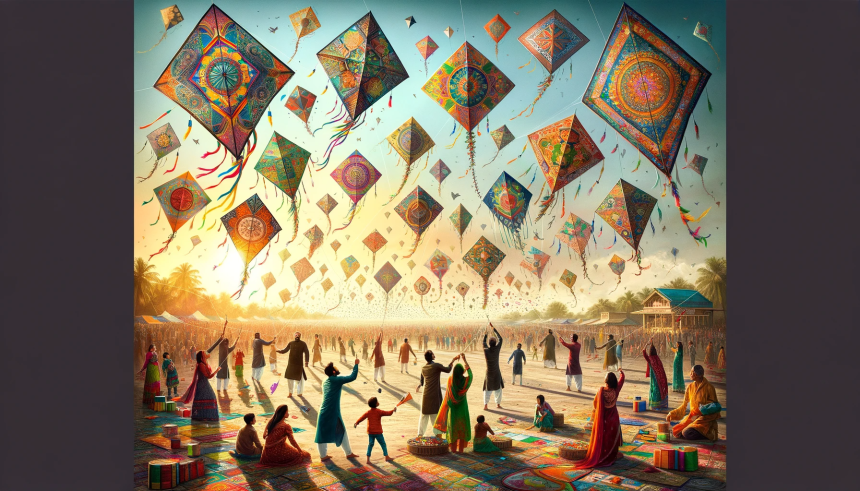As the sun embarks on its celestial journey northward, a festival of color, hope, and harvest engulfs India – Makar Sankranti. Amidst this vibrant celebration, kite flying emerges not merely as a leisurely pursuit but as a cultural phenomenon, etching the sky with hues of tradition, symbolism, and communal harmony.
The Sky as a Canvas
From the golden sands of Tamil Nadu to the frost-kissed horizons of Himachal Pradesh, the art of kite flying surpasses mere geographic confines. Each region unfurls its narrative through “pattams” and “patangs,” kites adorned with intricate designs and mythic symbols. These airborne marvels narrate tales of celestial battles, sacred prayers on the breeze, and auspicious desires mingling with the clouds.
Symbolism Aloft
Kite flying transcends the bounds of play, embedding profound cultural symbolism. Kites, soaring high, are believed to usher away negativity, opening vistas for prosperity and good fortune. They embody human aspirations and resilience, symbolizing the collective spirit to rise above life’s challenges. In the intricate dance of kites across the sky, a tapestry of communal unity and shared exuberance is woven, binding diverse hearts in a singular moment of joy.
A Panorama of Regional Traditions
The kaleidoscope of kite-flying traditions paints a rich, varied cultural landscape. Gujarat’s International Kite Festival transforms Ahmedabad into a vibrant spectacle, while Punjab’s aerial duels feature sharp-edged “patangs” in a show of skill and strategy. West Bengal’s owl-shaped “Tukools” soar as emblems of wisdom. Each region contributes its distinct cultural flavor, enriching the tradition with local folklore and customs.
Generational Echoes
This tradition, echoing through generations, nurtures a bond transcending time. Elders recount tales of kites from bygone days, imparting skills and spirit to younger generations. It’s a living legacy, animating the skies annually with laughter, anticipation, and a deep-rooted connection to heritage.
The Ethereal Symphony of Sankranti
As kites bedeck the Indian skies during Sankranti, the festival transforms into an ode to communal hope, dreams taking flight, and the enduring resonance of tradition.
Deeper Reflections:
- Cultural Imprints: Delve into the unique designs and motifs of kites, each echoing a regional story or belief.
- Sustainability in Tradition: Address the environmental aspects of kite flying while exploring eco-friendly innovations.
- Personal Narratives: Share poignant stories or experiences that capture the essence of kite flying during Sankranti, painting a picture of personal connections and memories.
- Historical Threads: Investigate the rich history of kite flying in India, tracing its roots and evolution in relation to the festival, to understand how this tradition has woven itself into the cultural fabric of the country.
Conclusion:
Kite flying during Makar Sankranti is more than a festive activity; it’s a vibrant expression of cultural heritage, community bonding, and the shared joy of humanity. As we observe the colorful skies, we are reminded of the enduring allure of traditions that bind us to our roots and to each other. It’s a celebration that transcends time and age, inviting us to look up and marvel at the beauty of collective aspirations and the boundless spirit of human dreams, soaring high in the skies of tradition and culture.








